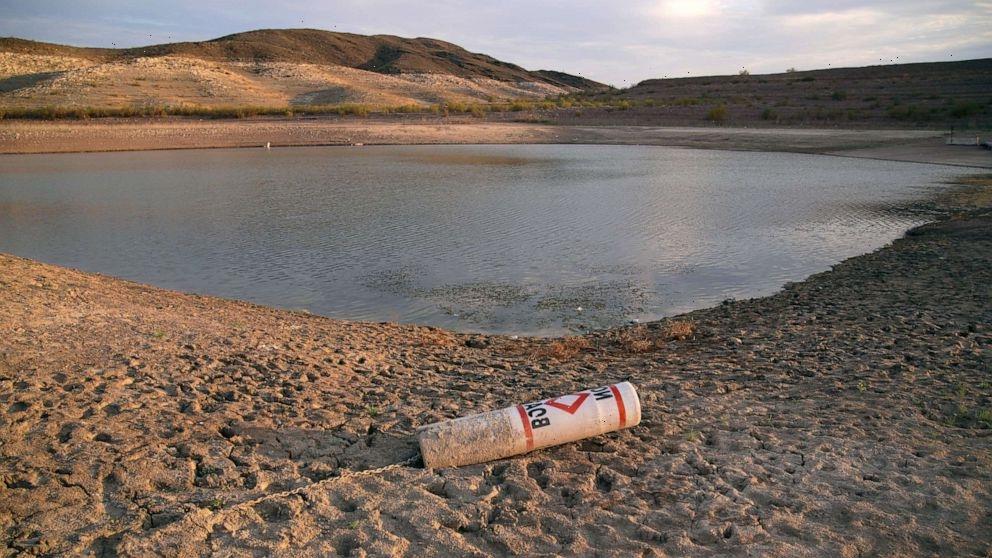Federal officials have declared a shortage in Lake Mead, the largest reservoir in the country that serves tens of millions of residents in the West and northern Mexico, amid a historic decadeslong “megadrought” in the region.
The Bureau of Reclamation announced the first-ever water shortage for the lower Colorado River basin on Monday, which will prompt a reduction in water releases to Arizona, Nevada and Mexico in 2022 to make sure there is enough water in the reservoir to keep generating power and provide water for essential uses.
Lake Mead will be under a Tier 1 shortage, meaning that starting next year, Arizona will receive about 18% less water from the Colorado River than in a typical year. Nevada’s water allowance will be reduced by about 7%, and Mexico’s by about 5%, according to the Bureau of Reclamation. States, local agencies, tribes and water users will negotiate which users see the most reductions.
In Arizona, for example, farmers will bear the brunt of the reductions, while cities and one tribe will see small reductions under the state’s drought contingency plan, though some have also made voluntary efforts to reduce water use.
The impacts of the water cuts to Central Arizona farmers will be serious and representatives from the irrigation districts anticipate as much as 30% of the farmland in Pinal County could be left unplanted next year, Kevin Moran, senior director of the Colorado River Program for the Environmental Defense Fund, told ABC News.
He said that it will be crucial for states and water users to continue to work together to adapt and conserve as much of the watersheds out west as possible to prepare for worsening conditions in the future.
“I think it’s a wake up call for everyone that we need to start planning for the river that scientists tell us we’re probably going to have not the one we remember or might wish for,” he said.
The reservoir hit its lowest water levels in history this summer, the bureau announced in June. The Colorado River system currently has only 40% of the amount of water it can store, down from 49% last year.
The lowering water levels in several reservoirs in the West have been exacerbated by severe drought, meaning less snowpack to feed into rivers, streams and lakes in areas surrounding the mountains. And what little runoff there is from snow in the spring is immediately sopped up by the arid soil before it can reach important bodies of water.
After 22 years of drought conditions, the water levels at the Hoover and Glen Canyon Dam reservoirs hit the lowest water levels since they were filled, Interior Assistant Secretary for Water and Science Tanya Trujillo told reporters in a press briefing Monday.
“We are seeing the effects of climate change in the Colorado River Basin through extended drought, extreme temperatures, expansive wildfires, and in some places flooding and landslides, and now is the time to take action to respond to them,” Trujillo said.
The Bureau of Reclamation, states, tribes, and water users have been planning for drought conditions to become more severe and created contingency plans on who would have their water allowance reduced first. In addition to helping farmers and other water users voluntarily reduce water use.
Levels of Lake Mead are projected to hit a level that could require additional cuts in July 2023. State officials said they will have to make difficult decisions to adapt to more limited water resources going into the future and that states will need to work together to come up with innovative solutions, according to the new analysis released by the Bureau of Reclamation.
“Today’s Colorado River hydrology is not the same hydrology this basin knew a century ago. Every community, every sector, every industry that uses Colorado River water must do more to conserve and protect this critical water resource upon which 40 million Americans depend,” said John Entsminger, general manager of the Southern Nevada Water Authority.
Tom Buschatzke, director of the Arizona Department of Water Resources, called the declaration and projections a “serious turn of events” but not a crisis, saying the state and stakeholders can make changes to limit water usage into the future.
“The challenge before us, to help protect the lake further and to protect 1020 elevation will be daunting, but we can and will address these issues, and be successful together in partnership,” he said.
But the conditions have worsened faster than expected, prompting the shortage declaration this year and possibly more reductions and actions in the future if drought conditions continue.
“The announcement today is a recognition that the hydrology that was planned for years ago but we hoped we would never see, is here,” said Bureau of Reclamation Deputy Commissioner Camille Touton.
Moran said the shortage declaration shows the river is “ground zero” for climate change in the US.
“We’re seeing the impact of climate change and the interconnected crises of drought, wildfires and extreme heat, and we need to adapt on an accelerated basis to those impacts,” he told ABC News.
Moran added that he thinks the world is at a point of “accelerated climate change” that is forcing them to “grapple with the health of the hydrologic system and what it can actually sustain.”
“We’re having to face that in ways we have, we have been able to avoid, at least in significant ways until now,” he added.
But Moran said the Bureau of Reclamation and water users were able to come together to plan for this water shortage, adding that “failure is not an option” going forward.
Source: Read Full Article





